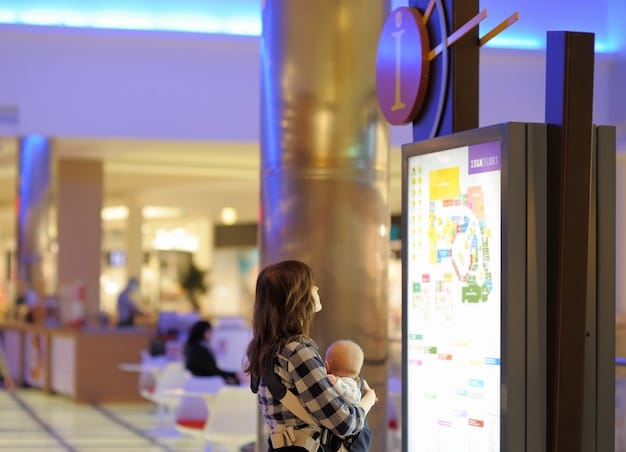The Future of Retail: Adapting to Consumer Preferences in 2025

The future of retail hinges on adapting to evolving consumer preferences through personalized experiences, seamless omnichannel integration, and leveraging innovative technologies like AI and AR to enhance customer engagement and satisfaction.
The retail landscape is undergoing a seismic shift, driven by rapidly changing consumer preferences and technological advancements. To thrive in this dynamic environment, retailers must embrace innovative strategies and adapt to the evolving needs of their customers. This article explores the future of retail: adapting to changing consumer preferences, examining key trends and strategies that will shape the industry in 2025 and beyond.
understanding the evolving consumer landscape
The key to navigating the future of retail is a deep understanding of the evolving consumer. Consumers are more informed, demanding, and connected than ever before. They expect personalized experiences, seamless omnichannel integration, and convenient shopping options. Retailers must adapt to these changing expectations to remain competitive.
The rise of the conscious consumer
Consumers are increasingly concerned about ethical and sustainable practices. They are more likely to support brands that align with their values and demonstrate a commitment to social and environmental responsibility.
The demand for personalized experiences
Generic marketing messages are no longer effective. Consumers want personalized experiences that cater to their individual needs and preferences. Retailers must leverage data and technology to deliver targeted offers and recommendations.
- Personalized product recommendations based on browsing history
- Loyalty programs tailored to individual spending habits
- Exclusive offers and discounts based on customer demographics
To meet these evolving demands, retailers need to focus on personalization. This goes beyond simply addressing customers by name in marketing emails. It involves collecting and analyzing data to understand individual preferences, behaviors, and needs. Retailers can then use this information to create highly targeted marketing campaigns, personalized product recommendations, and customized shopping experiences.

omnichannel retail: creating seamless experiences
Omnichannel retail is no longer a buzzword; it’s a necessity. Consumers expect a seamless shopping experience across all channels, whether they are browsing online, shopping in-store, or interacting with a brand on social media. Retailers must integrate their online and offline operations to provide a consistent and convenient customer journey.
The importance of mobile integration
Mobile devices are central to the consumer shopping experience. Retailers must optimize their websites and apps for mobile and leverage mobile technology to enhance the in-store experience.
Bridging the gap between online and offline
Retailers must create a seamless experience that allows customers to easily transition between online and offline channels. This includes options like buy online, pick up in-store (BOPIS) and in-store returns for online purchases.
- Implementing BOPIS options to cater to convenience-seeking customers
- Offering in-store returns for online purchases to build trust and reduce friction
- Providing real-time inventory updates across all channels
The key to successful omnichannel retail is data integration. Retailers need to consolidate customer data from all touchpoints to create a single view of the customer. This allows them to deliver personalized experiences across all channels, track customer behavior, and optimize their operations.
leveraging technology to enhance the customer experience
Technology is transforming the retail industry, creating new opportunities to enhance the customer experience and drive sales. Retailers must embrace innovative technologies like artificial intelligence (AI), augmented reality (AR), and virtual reality (VR) to stay ahead of the curve.
The power of artificial intelligence in retail
AI can be used to personalize the customer experience, optimize pricing and inventory, and improve operational efficiency. Chatbots, for example, can provide instant customer support and answer common questions.
Augmented and virtual reality: immersive shopping experiences
AR and VR can create immersive shopping experiences that allow customers to visualize products in their homes or try on clothes virtually. This can help to reduce returns and increase customer satisfaction.

By integrating technologies such as AR, retailers can transform the shopping experience. Customers can use their smartphones or tablets to overlay virtual models of products onto their real-world environments, allowing them to see how furniture would look in their homes or try on clothing virtually. This not only enhances the shopping experience but also reduces the likelihood of returns, as customers can make more informed purchase decisions.
the role of data analytics in understanding consumer behavior
Data analytics is crucial for understanding consumer behavior and optimizing retail operations. Retailers can use data to identify trends, personalize marketing campaigns, and improve inventory management. This data-driven approach allows retailers to make more informed decisions and better serve their customers.
Collecting and analyzing customer data
Retailers must collect data from all touchpoints, including online browsing, in-store purchases, and social media interactions. This data can then be analyzed to identify patterns and trends.
Using data to personalize marketing campaigns
Data analytics can be used to personalize marketing campaigns by identifying customer segments and tailoring messages to their specific needs and preferences.
- Analyzing purchase history to identify customer preferences
- Tracking website browsing behavior to understand customer interests
- Using social media data to identify customer demographics and lifestyle
One of the key benefits of data analytics is its ability to predict future trends and behaviors. By analyzing historical data, retailers can identify patterns and predict future demand for specific products or services. This allows them to optimize their inventory management, reduce waste, and improve profitability.
sustainability and ethical practices in retail
Sustainability and ethical practices are becoming increasingly important to consumers. Retailers must demonstrate a commitment to social and environmental responsibility to attract and retain customers. This includes sourcing products responsibly, reducing waste, and supporting fair labor practices.
Sourcing products responsibly
Consumers are increasingly concerned about the origins of the products they buy. Retailers must ensure that their products are sourced ethically and sustainably.
Reducing waste and promoting circular economy
Retailers can reduce waste by implementing recycling programs, reducing packaging, and promoting the circular economy. This includes initiatives like product take-back programs and resale platforms.
the future of brick-and-mortar stores
While online retail continues to grow, brick-and-mortar stores still play a vital role in the retail landscape. However, the role of the physical store is evolving. In the future, brick-and-mortar stores will focus on providing experiences and building relationships with customers.
Creating experiential retail environments
Retailers must create experiential retail environments that offer unique and engaging experiences. This includes interactive displays, personalized services, and community events.
Building relationships with customers
Brick-and-mortar stores can be used to build relationships with customers by providing personalized service, hosting events, and creating a sense of community. This can help to foster loyalty and drive repeat business.
Brick-and-mortar stores can also leverage technology to enhance the customer experience. For example, retailers can use beacon technology to track customer movements in the store and deliver personalized offers to their smartphones. They can also use interactive displays to provide product information and recommendations.
| Key Point | Brief Description |
|---|---|
| 🛍️ Personalized Experiences | Tailoring shopping experiences to individual customer preferences. |
| 📱 Omnichannel Integration | Providing seamless shopping across online and offline channels. |
| 💡 Technology Adoption | Leveraging AI, AR, and VR to enhance customer engagement. |
| 🌍 Sustainable Practices | Committing to ethical sourcing and reducing environmental impact. |
Frequently Asked Questions
▼
AI is revolutionizing retail by personalizing shopping experiences, optimizing inventory management, and enhancing customer service through chatbots and predictive analytics, leading to greater efficiency and customer satisfaction.
▼
Omnichannel retail integrates online and offline shopping channels, offering a seamless customer experience. This is crucial because today’s consumers expect to interact with brands effortlessly across all platforms.
▼
Sustainability is vital as consumers increasingly favor brands with ethical and eco-friendly practices. Retailers prioritizing sustainability can enhance their brand reputation and attract a growing segment of conscious consumers.
▼
Data analytics helps retailers understand consumer behavior, personalize marketing, and optimize inventory. By analyzing customer data, retailers can make informed decisions and improve overall business performance.
▼
Brick-and-mortar stores provide experiential shopping environments and foster direct customer relationships. These stores are evolving to offer unique in-person experiences that complement online shopping, enhancing brand loyalty.
Conclusion
As we look to 2025 and beyond, the retail landscape will continue to be shaped by evolving consumer preferences and technological advancements. Retailers who embrace change, prioritize the customer experience, and leverage the power of data and technology will be best positioned to thrive in this dynamic environment. By focusing on personalization, omnichannel integration, and sustainability, retailers can create a future where customers are not just satisfied but delighted.





